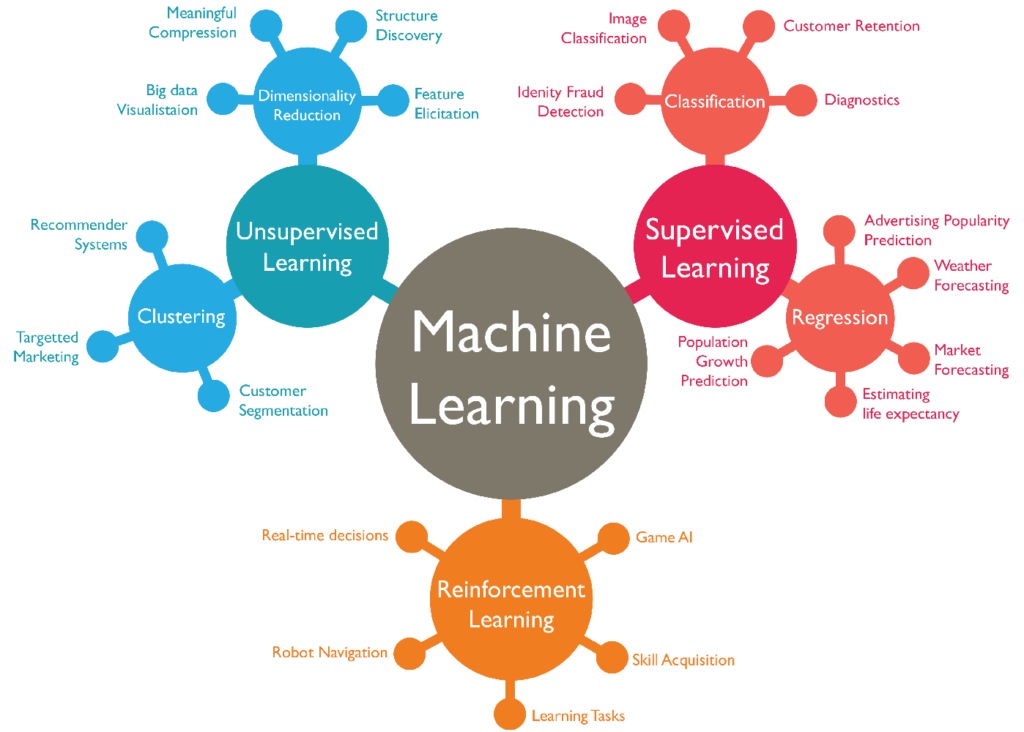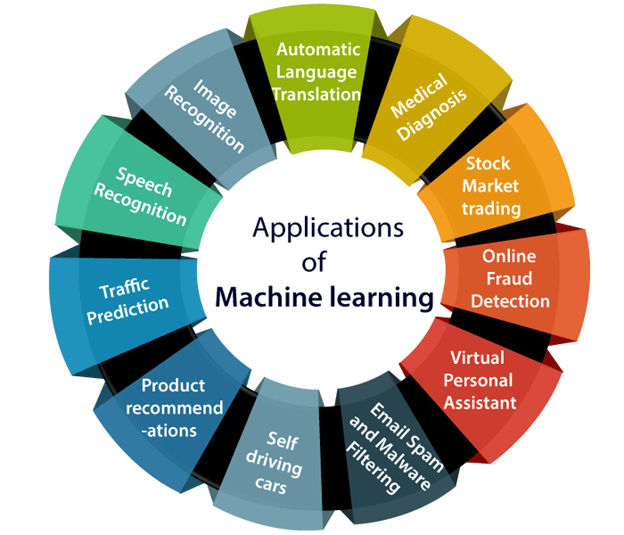Machine Learning
What is Machine Learning?
Machine Learning (ML) is a sub-category of artificial intelligence that refers to the process by which computers develop pattern recognition, or the ability to continuously learn from and make predictions based on data, then make adjustments without being specifically programmed to do so.
Whether or not you’re excited by the idea of artificial neural networks one day growing sophisticated enough to replicate human consciousness, there are undeniable practical advantages to machine learning, namely:
Intelligent big data management – The sheer volume and variety of data being generated as humans and other environmental forces interact with technology would be impossible to process and draw insights from without the speed and sophistication of machine learning.
Smart devices – From wearable devices that track health and fitness goals to self-driving cars to “smart cities” with infrastructure that can automatically reduce wasted time and energy, the Internet of Things (IoT) holds great promise, and machine learning can help make sense of this significant increase in data.
Rich consumer experiences – Machine learning enables search engines, web apps and other technology to customise results and recommendations to match user preferences, creating delightfully personalised experiences for consumers.
How does machine learning work?
Machine learning is incredibly complex and how it works varies depending on the task and the algorithm used to accomplish it. However, at its core, a machine learning model is a computer looking at data and identifying patterns, and then using those insights to complete its assigned task more effectively. Any task that relies upon a set of data points or rules can be automated using machine learning, even those more complex tasks such as responding to customer service calls and reviewing CVs.
Depending on the situation, machine learning algorithms function using more or less human intervention/reinforcement. The four major machine learning models are supervised learning, unsupervised learning, semi-supervised learning and reinforcement learning.
With supervised learning, the computer is provided with a labelled set of data that enables it to learn how to do a human task. This is the least complex model, as it attempts to replicate human learning.
With unsupervised learning, the computer is provided with unlabelled data and extracts previously unknown patterns/insights from it. There are many different ways that machine learning algorithms do this, including:
Clustering, in which the computer finds similar data points within a data set and groups them accordingly (creating “clusters”).
Density estimation, in which the computer discovers insights by looking at how a data set is distributed.
Anomaly detection, in which the computer identifies data points within a data set that are significantly different from the rest of the data.
Principal component analysis (PCA), in which the computer analyses a data set and summarises it so that it can be used to make accurate predictions.
With semi-supervised learning, the computer is provided with a set of partially labelled data and performs its task using the labelled data to understand the parameters for interpreting the unlabelled data.
With reinforcement learning, the computer observes its environment and uses that data to identify the ideal behaviour that will minimise risk and/or maximise reward. This is an iterative approach that requires some kind of reinforcement signal to help the computer better identify its best action.
How are deep learning and machine learning related?
Machine learning is the broader category of algorithms that are able to take a data set and use it to identify patterns, discover insights and/or make predictions. Deep learning is a particular branch of machine learning that takes ML’s functionality and moves beyond its capabilities.
With machine learning in general, there is some human involvement in that engineers are able to review an algorithm’s results and make adjustments to it based on their accuracy. Deep learning doesn’t rely on this review. Instead, a deep learning algorithm uses its own neural network to check the accuracy of its results and then learn from them.
A deep learning algorithm’s neural network is a structure of algorithms that are layered to replicate the structure of the human brain. Accordingly, the neural network learns how to get better at a task over time without engineers providing it with feedback.
The two major stages of a neural network’s development are training and inference. Training is the initial stage in which the deep learning algorithm is provided with a data set and tasked with interpreting what that data set represents. Engineers then provide the neural network with feedback about the accuracy of its interpretation, and it adjusts accordingly.
There may be many iterations of this process. Inference is when the neural network is deployed and is able to take a data set it has never seen before and make accurate predictions about what it represents.
How MLOps delivers the benefits of machine learning across enterprise applications
Machine learning is the catalyst for a strong, flexible and resilient enterprise. Smart organisations choose ML to generate top-to-bottom growth, employee productivity and customer satisfaction.
Many enterprises achieve success with a few ML use cases, but that’s really just the beginning of the journey. Experimenting with ML may come first, but what needs to follow is the integration of ML models into business applications and processes so it can be scaled across the enterprise.
Many organisations lack the skills, processes and tools to accomplish this level of enterprise-wide integration. In order to successfully achieve ML at scale, companies should consider investing in MLOps, which includes the process, tools and technology that streamline and standardise each stage of the ML lifecycle, from model development to operationalisation. The emerging field of MLOps aims to deliver agility and speed to the ML lifecycle. It can be compared to what DevOps has done for the software development lifecycle.
To progress from ML experimentation to ML operationalisation, enterprises need strong MLOps processes. MLOps not only gives an organisation a competitive edge but also makes it possible for the organisation to implement other machine learning use cases. This results in other benefits, including the creation of stronger talent through increased skills and a more collaborative environment, plus increased profitability, better customer experiences and increased revenue growth.
How enterprises are using machine learning
Across vertical industries, ML technologies and techniques are being deployed successfully, providing organisations with tangible, real-world results.
In financial services for example, banks are using ML predictive models that look across a massive array of interrelated measures to better understand and meet customer needs. ML predictive models are also capable of uncovering and limiting exposure to risk. Banks can identify cyber threats, track and document fraudulent customer behaviour, and better predict risk for new products. Top use cases for ML in banking include fraud detection and mitigation, personal financial adviser services, and credit scoring and loan analysis.
In manufacturing, companies have embraced automation and are now instrumenting both equipment and processes. They use ML modelling to reorganise and optimise production in a way that is both responsive to current demand and conscious of future change. The end result is a manufacturing process that is both agile and resilient. The top three ML use cases identified in manufacturing include yield improvements, root cause analysis, and supply chain and inventory management.

HPE machine learning solutions span from enterprise to edge
HPE offers machine learning to untangle complexity and create end-to-end solutions – from the core enterprise data centre to the intelligent edge.
HPE Apollo Gen10 systems offer an enterprise deep learning and machine learning platform with industry-leading accelerators that deliver exceptional performance for faster intelligence.
The HPE Ezmeral software platform is designed to help enterprises accelerate digital transformation across the organisation. It enables them to increase agility and efficiency, unlock insights and deliver business innovation. The complete portfolio spans artificial intelligence, machine learning and data analytics, as well as container orchestration and management, cost control, IT automation, AI-driven operations and security.
The HPE Ezmeral ML Ops software solution extends the capabilities of the HPE Ezmeral Container platform to support the entire machine learning lifecycle and implement DevOps-like processes to standardise machine learning workflows.
To help enterprises move rapidly beyond ML proofs-of-concepts to production, HPE Pointnext Advisory and Professional Services provides the expertise and services needed to deliver ML projects. With experience delivering hundreds of workshops and projects across the world, HPE Pointnext experts provide the skills and expertise to accelerate project deployments from years to months to weeks.

To Read More About AI Click Here
Buy From Amazon
